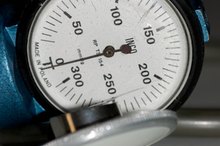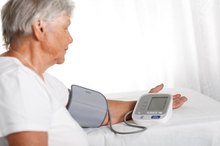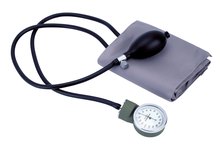Causes of Error in Measuring Blood Pressure
Hypertension is known as a silent killer for it rarely has symptoms initially. It is important to treat hypertension early as it can lead to heart disease and stroke. As hypertension has many serious side effects it is imperative to accurately obtain blood pressure. Errors can lead to treatment of a non-existent condition or undertreat a more serious one.
Cuff Size
Inside of the blood pressure cuff is a bladder that inflates to cut off blood flow in the arm. If the bladder, not the cuff itself, does not encircle at least 80 percent of an adult arm then the blood pressure will be artificially higher, according to the online resource for medical professionals, Medscape. A large adult cuff is more suitable for most adult arms, but if the cuff is too large, it can also falsely affect blood pressure.
Posture
What Is the Formula for Calculating Blood Pressure?
Learn More
The December 2009 issue of “The Journal of Family Practice” published an article on treating patient’s blood pressure. This article states pseudo hypertension can happen from improper posture. To obtain proper blood pressure, the body needs to be seated with back supported, legs uncrossed, arm horizontal to the ground with the cuffed area of the arm at the level of the heart. Allowing the arm to hang by the side instead of being horizontal can raise the BP by 23/10 mmHg respectively. This margin of error could make a healthy person appear hypertensive.
- The December 2009 issue of “The Journal of Family Practice” published an article on treating patient’s blood pressure.
- Allowing the arm to hang by the side instead of being horizontal can raise the BP by 23/10 mmHg respectively.
Listening Skills
The sounds heard during blood pressure readings are broken up into five distinct phases or Korotkoff sounds. Some operators record the diastolic number sooner than recommended. The fourth phase is when the sound becomes more muffled before it disappears completely (phase V). Recording the lower BP number at phase IV versus phase V leads to a higher diastolic pressure. Additionally, “Hospital Physician” published an article in March of 2002 stating another common sound error is failing to detect the auscultatory gap. This gap is a period of silence that happens when listening for the pressure. Failing to detect this gap leads to a lower systolic pressure. This problem is easily avoided by inflating the cuff until there is an absence of the radial pulse.
- The sounds heard during blood pressure readings are broken up into five distinct phases or Korotkoff sounds.
- Recording the lower BP number at phase IV versus phase V leads to a higher diastolic pressure.
Operator Errors
How Do Automatic Blood Pressure Monitors Work?
Learn More
The “British Medical Journal” published the ABC of hypertension Blood Pressure Management in April of 2001. A common operator error is observer error and preference. The article noted that many operators have a preference to end numbers in 0 or 5 for BP readings, leading to a lowering or rising of 2 to 3 mmHg in both numbers. Additionally operators tend to round down the numbers if the person getting the measurement appears healthy, and round up if the person appears overweight or unhealthy. The article goes on to state rapid inflation and deflation of the cuff by the operator can lead to artificially lower systolic and higher diastolic numbers.
- The “British Medical Journal” published the ABC of hypertension Blood Pressure Management in April of 2001.
- The article goes on to state rapid inflation and deflation of the cuff by the operator can lead to artificially lower systolic and higher diastolic numbers.
Environment
Many things can affect blood pressure, from exercise to supplements to over-the-counter medications. It is important to ask patients if they have smoked, had coffee, or taken medications recently before recording the blood pressure as many of these things can raise the blood pressure. Medscape also mentions the possibility of “white coat hypertension,” which is an artificially higher pressure when the doctor is in the room taking blood pressure. Any elevated reading should be re-checked at a later time in the visit and multiple readings need to be obtained before a diagnosis of hypertension is made.
- Many things can affect blood pressure, from exercise to supplements to over-the-counter medications.
- It is important to ask patients if they have smoked, had coffee, or taken medications recently before recording the blood pressure as many of these things can raise the blood pressure.
Related Articles
References
- “The Journal of Family Practice;” When your patient’s blood pressure won’t come down.; David Feldmand, MD, PhD and Randy Wexler, MD, MPH.; December 2009.
- American Heart Association. Understanding blood pressure readings.
- American Heart Association. Low blood pressure—when blood pressure is too low. Updated October 21, 2016.
- Centers for Disease Control and Prevention. High blood pressure symptoms, causes, and problems. Updated May 19, 2020.
- Salkic S, Batic-Mujanovic O, Ljuca F, Brkic S. Clinical presentation of hypertensive crises in emergency medical services. Mater Sociomed. 2014;26(1):12-16. doi:10.5455/msm.2014.26.12-16
- Institute for Quality and Efficiency in Health Care (IQWiG). What is blood pressure and how is it measured? InformedHealth.org. Updated May 23, 2019.
- American Heart Association. Know your risk factors for high blood pressure. Updated December 21, 2017.
- Sharma S, Hashmi MF, Bhattacharya PT. Hypotension. StatPearls. Updated May 23, 2020.
- American Heart Association. Health threats from high blood pressure. Updated October 31, 2017.
Writer Bio
Dr. Franchesca Vermillion is based in Portland, Ore. and has been writing health-related material for her patients and for public speaking events for more than four years. Vermillion obtained her Bachelor of Arts in molecular biology from the University of Denver in 2001 and her Chiropractic Physician's Degree from University of Western States in 2006.





